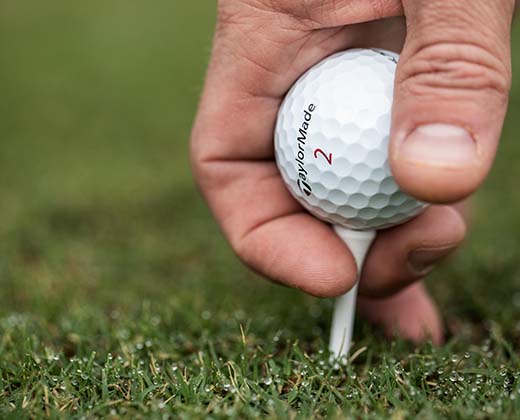How to Buy Golf Balls
Before you head to the course, make sure you have the right golf ball for your individual playing style.
There’s a certain science to a successful round on the course — ball speed, launch angle, spin. A series of mechanical factors coalesce when clubhead meets ball.
Want to achieve explosive distance off the tee? How about fine-tuned control on the green? There’s some serious technology packed into your golf ball, and you can learn to use it to your advantage with this golf ball buying guide.
THE ANATOMY OF THE GOLF BALL
What makes a golf ball fly? What determines how far it travels, or how much it spins? For a better understanding of a golf ball’s performance, start with an overview of its anatomy: core, cover and dimples.
Core
- The core is the power center of the golf ball and can have substantial influence over spin rate, initial velocity and, in particular, compression. A ball’s compression rating is the measurement of how much a ball will compress against a clubface on impact. Compression ratings of more than 100 are appropriate for golfers with high swing speeds who can carry drives more than 140 feet in the air. Golfers with slower swing speeds should consider a ball with a compression rating below 90.
Cover
- There are two main types of golf ball covers: Surlyn and urethane. Introduced in the 1960s, Surlyn is an ionomer resin that’s harder and more durable than urethane. However, it doesn’t provide much backspin, which can be a drawback for low-handicap golfers. Surlyn-covered golf balls can be a great choice for beginners. Urethane is softer and generally offers higher spin and improved control. Though softer than Surlyn, skilled golfers often prefer urethane for its shot-shaping potential.
Dimples
- Your golf ball is covered with small indentations, known as dimples, which are designed to both reduce drag and control ball trajectory. They may seem simple, but you shouldn’t overlook their importance, considering a smooth-surface golf ball would travel only half as far as one with dimples. Dimple patterns vary depending on the manufacturer and the type of ball you’re playing. The total number of dimples, as well as their shape, size and depth, can impact the way the ball performs in flight. Most golf balls have between 300–400 dimples.
GOLF BALL CONSTRUCTION
A key consideration when choosing a golf ball is the number of pieces in its construction. There are two main options: two-piece golf balls and multi-layer golf balls.
Two-Piece Golf Balls
- Two-piece golf balls are simply made up of the core and cover. These balls are a great choice for beginners and golfers with a high handicap. This design’s large core also promotes distance while helping to reduce hooks and slices off the tee, which are common issues for newer players. The covers on two-piece balls are typically thick and durable to help extend the life of the ball. This is an important feature if you find yourself making frequent contact with hard surfaces like cart paths, trees, etc.

Multi-Layer Golf Balls
- Multi-layer golf balls are designed for experienced players. These balls have additional layers between the cover and core to help elevate control, feel and shot sculpting. They also have a thin cover to help further enhance spin control and feel.

TYPES OF GOLF BALLS
You now know about the anatomy and construction, but you’re probably still asking, “What is the best golf ball for me?” Well, you can find the right fit for your game by learning more about the different categories of golf balls from which to choose.
Tour Performance Golf Balls
- These multi-layer golf balls are designed for experienced, mid- to low-handicappers. The series of core and mantle layers help enhance control and feel, allowing golfers to sculpt shots and create added spin around the green. The thinner cover construction can further enhance spin control while providing the crisp feel serious golfers demand.
Soft Feel Golf Balls
- Soft feel is often synonymous with low compression. Low compression can allow for more deformation of the ball at impact, which can reduce spin and translate to straighter, longer flight on low-lofted clubs. The prolonged contact on short irons and wedges can result in softer feel.
Distance Golf Balls
- Featuring a firmer cover and multi-layer design, distance balls feature a larger center core to help support maximum carry while minimizing the spin that exaggerates slices and hooks.
SEPARATE YOURSELF FROM THE PACK
If you’re looking for a ball that will stand out on the course, consider high-visibility or personalized golf balls.
High-Visibility Golf Balls
- While they were more of a novelty in the past, high-visibility golf balls are increasingly preferred by players of all skill levels. These balls can be easier to track in the air and on the ground, helping you locate your shots faster. The high-vis category continues to evolve with bold new patterns, colors and matte finishes. Many of today’s top-selling golf balls are now available in high-vis colors. Learn more with our high-visibility golf balls guide.
Personalized Golf Balls
- You can add your name, initials, favorite quote or funny saying to personalized golf balls. Personalization is available on most types of balls and is one of the most popular gifts for golfers.
Now that you have a better understanding of the anatomy and construction of golf balls, and you know the difference between the various types of golf balls, you’re ready to find the kind that’s best for you!








